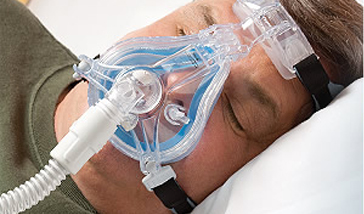OBSTRUCTIVE SLEEP APNEA
What does Obstructive Sleep Apnea mean? (OSA)
CPAP UNITS

MASKS

20 million men and women in USA suffer from obstructive sleep apnea. People with obstructive sleep apnea stop breathing repeatedly during sleep because of the collapse of the upper respiratory tract. The cause for this can be big tongue, extra tissue in the upper respiratory tract or shorten muscular tonus that keeps the pharynx open. As a result, air is obstructed to get in the lungs. These pauses in breathing can appear up to 30 times and more during one hour of sleep. When healthy sleeping is disordered in this way, it reflects on the heart work and can lead to numerous serious health problems.
How do I know I have obstructive sleep apnea?
Obstructive sleep apnea can appear at men, women and children of all ages. Most people with obstructive apnea are not aware of their condition. Most often, someone else is a witness of the first signs of obstructive sleep apnea. If you or someone you know has one or more of the following symptoms, it may be the case of obstructive sleep apnea.One of the basic signs and symptoms are the following:
● Expressed daily drowsiness● Loud and annoying snoring
● Gasping and choaking during sleep
Other usual symptoms include:
● Tiredness and morning headaches● Often urinating during the night
● Depression and irritability
● Obesity
● Large neck or accumulated secretion in the upper respiratory tract
● Women in menopause
What happens if I know I have obstructive sleep apnea and don't treat it right?
People with undiagnosed and without effective therapy for obstructive sleep apnea are exposed to a great risk of:● High blood pressure
● Arrhythmia or heart illness
● Heart attack
● Brain stroke
● Increased probability of car accident or accident at work
How to diagnose obstructive sleep apnea?
● Talk to your doctor for the symptoms and sleeping troubles● If there is a doubt for a sleeping disorder your doctor is going to direct you to a specialist in this filed
● All night diagnostic testing known as polysomnography or PSG is used for detecting the type and seriousness of the disorder, as well as giving a therapy
What is the therapy for obstructive sleep apnea?
● Positive air pressure (PAP) is one of the therapy for obstructive sleep apnea.● PAP therapy presents gentle flow of air pressure through your nose using a mask.
● Air pressure prevents the collapse in the upper respiratory tract which allows normal breathing during the night.
● PAP therapy is non-invasive and can completely remove the symptoms of obstructive sleep apnea if used as prescribed.
CPAP – Optional therapy
● CPAP or continuous positive air pressure is the most often used PAP therapy● CPAP provides continuous flow of combined air that keeps respiratory tract open.
● Some CPAP systems of Respironics company have C-Flex algorithm that lowers pressure through expiration to allow maximum comfort.
Other therapies:
● Bi-level PAP can be prescribed for more complex cases● Auto PAP (Auto CPAP or BiPAP) adjusts pressure to your needs-automatically while you’re sleeping.
● Surgery
● Adaptation of body position while sleeping
● Oral protesis
What are the advantages of the right therapy?
● Increased energy and awareness during the day● Lowering of the blood pressure
● Decreased risk of heart and brain stroke
● Greater efficiency at home or at work
● Better life quality
Solution for an effective therapy for obstructive sleep apnea
In the first weeks of the therapy, you may face problems with adaption on the therapy. Those problems are easy to solve when you look for help from the agent of the instrument or your doctor.Discomforts regarding the mask
● Red dots - tighten your mask● Leaking air of the mask - adjust the tighteners until leaking stops
● Troubles with appropriate fiiting- adjust the tighteners or take another size of the mask.
Discomfort regarding the nose and mouth
The feeling of discomfort in the nose and mouth will withdraw as time passes. If not, try the following:● Drink large amounts of water
● Use physiologic nasal spray
● Try with nasal decongestives
● Add air moisturizing of your PAP unit
Discomfort regarding the air pressure.
Ask your distributer whether these settings are in available on your unitDifferent settings of your unit like ramp or flex can help you to adapt the pressure. Ask your distributer whether these settings are present on your unit.
Living with that
It is important to be an active participant in the therapy and focus on its advantages.● Use your unit every night even when you travel. Sleep apnea will appear those nights when you don't use the unit.
● Be patient and persistent while adapting to the therapy.
● Talk to your doctor or with you distributer where from the unit is supplied, if you come across any problems.
● Ask for support from your family, local groups of patients with similar symptoms or the internet.
● Think about changing your life habits, like losing weight (if necessary), improving sleeping habits, avoiding use of alcohol, sedatives and hypnotics.
Important:
If the symptoms of obstructive sleep apnea appear after starting the PAP therapy, contact your doctor to discuss the therapy.What Patients Are Saying?

